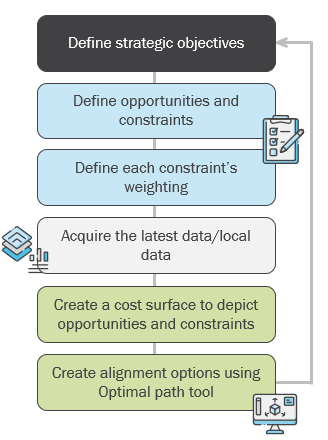With Australia requiring thousands of kilometres of new transmission lines to support our energy transition, we face a critical challenge: how can we plan these routes quickly whilst integrating environmental values and community interests?
Traditional approaches often pit these priorities against each other, resulting in disputes and costly delays. By integrating advanced spatial modelling with local expertise and structured stakeholder engagement, we can identify transmission corridors that balance technical, social, cost, and environmental considerations—delivering better outcomes in shorter timeframes.
Electricity Grid Transformation
A revised approach to route planning is required as Australia undergoes its largest electricity grid transformation in line with the optimal development path identified in the Australian Energy Market Operator’s 2024 Integrated System Plan. The scale of new lines and investment required coincides with growing community opposition and calls for better outcomes.
The traditional sequential approach—engineering first, then environmental and social considerations—creates a range of risks. We need a new methodology that integrates environmental constraints and stakeholder feedback into engineering decisions in the early phases, avoiding the usual and costly "plan, announce, defend" cycle.
Our Insights
Accelerating transmission development while minimising community friction requires flipping the traditional planning model. Rather than treating route selection as primarily an engineering exercise, a structured data-driven approach integrates the environmental and community elements from day one.
Our aim is to reduce corridor and route identification time, consider the whole of environment and improve stakeholder acceptance using four interconnected principles:
- Establish strategic objectives: A series of questions are asked to see the big picture – what are the goals of this project? What are we trying to achieve? This process takes a whole of environment approach accounting for a wide variety of factors. Key strategic objectives can include maximising preferred land use, minimising land use conflicts and environmental impacts, reducing risks, and building community support. These are then distilled into the most important aspects that will drive future decisions.
- Tiered Constraint Classification: A hierarchical framework classifies impacts and opportunities into priority tiers, creating transparent decision-making. This isn't just about flagging issues; it's about understanding their significance. The framework clarifies why certain routes are unviable, enabling meaningful modifications.
- Cost Surface Modelling: By quantifying the tiered constraints, we can rapidly generate and compare a multitude of route options. This allows us to quickly identify the most viable paths based on a clear understanding of the trade-offs, significantly accelerating the corridor identification process without sacrificing the depth of our analysis.
- Iterative Visualisation and model validation: Dynamic 3D visualisation tools empowers stakeholders to "see" potential corridors in their environment. As stakeholders provide input, they can witness in near real-time how their feedback shapes the corridor options. This transforms consultation to a collaborative approach. The model is also validated and preferred options informed by local expertise and technical knowledge as field data is collected. The model validation and feedback loop continues as options are continually refined.

How will this approach impact the Energy Transition?
Our approach to route options development offers:
- Accelerated Implementation: By prioristising constraints analysis and stakeholder engagement early on, we can help to achieve ambitious timelines for integrating renewable energy into the grid.
- Defensible Decision-Making: Our reproducible methodology creates a clear audit trail linking strategic objectives to the choices made during route development and the alternatives that have been considered.
- Enhanced Social Licence: By demonstrating how community input and environmental factors influences route considerations we build greater trust and acceptance among stakeholders.
- Transferable Methodology: This systematic approach can be adapted for other infrastructure projects, creating consistency across development planning.
- Dynamic Visualisation: Utilising 3D modelling tools provides more accurate, flexible alternatives to traditional visualisation methods, facilitating meaningful engagement with non-technical stakeholders.
The growing scale and complexity of transmission infrastructure requires a collaborative approach. By integrating advanced spatial modelling with structured stakeholder engagement and local expertise, we can optimise routes while balancing technical, environmental, social, cost, and economic considerations.
This approach evolves beyond traditional mapping by leveraging environmental data and local knowledge to achieve better outcomes. EMM is committed to developing smarter, more sustainable, and ultimately, more successful infrastructure projects, built on a foundation of collaboration and trust.
_______________________________________